|
|
|
Sort Order |
|
|
|
Items / Page
|
|
|
|
|
|
|
| Srl | Item |
| 1 |
ID:
188731
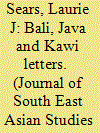

|
|
|
|
|
| Summary/Abstract |
I am not a specialist on Bali. I did live in Bali for more than a year in total over the past several decades, thus witnessing first hand its changing lifeways. I am a cultural and intellectual historian of Bali's neighbouring island of Java, and I carried out research on the central Javanese, specifically Solonese, shadow theatre in the early part of my career. I spent around five years in the city of Solo between 1972 and 1984, half of that time attending performances, and the other half hanging out with puppet masters, shadow theatre aficionados, and students of shadow theatre, and organising a project on collecting branch stories, stories that deviate from the trunk stories of the Solonese shadow theatre repertoire. The repertoire I was researching was the Javanese Mahabharata and Ramayana stories, a repertoire with which I was quite familiar. I was asked to be part of this special review to offer comparative insights between southern Balinese and central Javanese cultures from the point of view of the performing arts. From this perspective, I felt exhilarated to read Richard Fox's More than words and to read how literally alive Balinese letters, writ large and small, are in present-day Bali.
|
|
|
|
|
|
|
|
|
|
|
|
|
|
|
|
| 2 |
ID:
086849
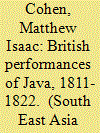

|
|
|
|
|
| Publication |
2009.
|
| Summary/Abstract |
This article looks at the reception of the British interregnum of Java (1811-1816) in the theatre through a comparison of Jane Scott's pantomime The Poison Tree (1811), George Colman the Younger's melodrama The Law of Java (1822) and the case of 'Princess Caraboo', a Devonshire serving girl who posed as a princess from 'Javasu' in Bristol in 1817 and later performed the story of her career as an impostor on stage in America. The author examines these productions in their historical contexts, as well as later stagings, including the film Princess Caraboo (1994) starring Phoebe Cates, and the 2006 Royal Holloway production of The Law of Java. He suggests that not only did stage interpretations of Java offer a ground for imperial fantasy and virtual travel, but they also presented opportunities for the articulation of a range of contemporary issues related to class, gender, human rights and modes of governance.
|
|
|
|
|
|
|
|
|
|
|
|
|
|
|
|
| 3 |
ID:
140118
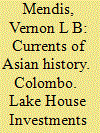

|
|
|
|
|
| Publication |
Colombo, Lake House Investments Ltd, Publishers, 1981.
|
| Description |
xx, 493p.pbk
|
|
|
|
|
|
|
|
|
|
|
|
Copies: C:1/I:0,R:0,Q:0
Circulation
| Accession# | Call# | Current Location | Status | Policy | Location |
| 030170 | 950/MEN 030170 | Main | On Shelf | General | |
|
|
|
|
| 4 |
ID:
115289
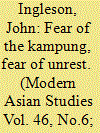

|
|
|
|
|
| Publication |
2012.
|
| Summary/Abstract |
This paper discusses the responses of The Netherlands Indies colonial government to the rise in urban unemployment in Java brought about by the 1930s Depression. At least one in six of the large European/Eurasian population in the colony, and an even larger proportion of urban Indonesian workers, became unemployed as a result of the Depression. The colonial government and the European community were greatly concerned that the growth of unemployment among Europeans would lead to destitution for many, ultimately forcing them into the native kampung1. They were also concerned about what they saw as the moral decay of local-born European/Eurasian youth who were unemployed in unprecedented numbers. Furthermore, the European community feared that the growth in unemployment among western-educated Indonesians in the towns and cities in Java would create a fertile recruitment ground for nationalist political parties leading to urban unrest. Fear of the kampung for destitute Europeans, and fear of urban unrest from unemployed western-educated Indonesians, shaped the colonial government's responses to urban unemployment. The impact of the Depression on both Indonesian and European unemployed in the towns and cities in Java triggered lengthy debates on the role of the state in the provision of social security.
|
|
|
|
|
|
|
|
|
|
|
|
|
|
|
|
| 5 |
ID:
117475
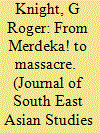

|
|
|
|
|
| Publication |
2012.
|
| Summary/Abstract |
Between 1945 and 1965, what may be broadly defined as the politics of sugar in Indonesia passed through several critical stages. The industrial manufacture of sugar had begun in the Netherlands Indies in the mid-nineteenth century, but after a slump during the 1930s Depression, the industry virtually went into abeyance during the Japanese Occupation (1942-45). After the war, the years of struggle for Merdeka! (freedom) also saw a partial revival of the industry, which continued through national revolution and independence (1949) through to an incremental nationalisation in the late 1950s. Developments in the sugar industry culminated in massacre, rather than merdeka, however. The campaign against the PKI (Indonesian Communist Party) which began in 1965 resulted in the murder of labour unionists and peasant activists associated with the sugar industry. This paper traces the course of events from Merdeka to massacre, focusing on the sugar industry of East Java's Brantas valley. Its themes, however, relate to the industry in Java as a whole, and the question of why the commodity production of sugar came to be so deeply embroiled in the politics of the new republic.
|
|
|
|
|
|
|
|
|
|
|
|
|
|
|
|
| 6 |
ID:
117476
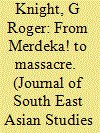

|
|
|
|
|
| Publication |
2012.
|
| Summary/Abstract |
Between 1945 and 1965, what may be broadly defined as the politics of sugar in Indonesia passed through several critical stages. The industrial manufacture of sugar had begun in the Netherlands Indies in the mid-nineteenth century, but after a slump during the 1930s Depression, the industry virtually went into abeyance during the Japanese Occupation (1942-45). After the war, the years of struggle for Merdeka! (freedom) also saw a partial revival of the industry, which continued through national revolution and independence (1949) through to an incremental nationalisation in the late 1950s. Developments in the sugar industry culminated in massacre, rather than merdeka, however. The campaign against the PKI (Indonesian Communist Party) which began in 1965 resulted in the murder of labour unionists and peasant activists associated with the sugar industry. This paper traces the course of events from Merdeka to massacre, focusing on the sugar industry of East Java's Brantas valley. Its themes, however, relate to the industry in Java as a whole, and the question of why the commodity production of sugar came to be so deeply embroiled in the politics of the new republic.
|
|
|
|
|
|
|
|
|
|
|
|
|
|
|
|
| 7 |
ID:
134281
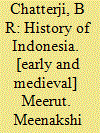

|
|
|
|
|
| Publication |
Meerut, Meenakshi Prakashan, 1967.
|
| Description |
vi, 205p.Hbk
|
| Contents |
B
|
|
|
|
|
|
|
|
|
|
|
|
Copies: C:1/I:0,R:1,Q:0
Circulation
| Accession# | Call# | Current Location | Status | Policy | Location |
| 057916 | 959.8/CHA 057916 | Main | On Shelf | Reference books | |
|
|
|
|
| 8 |
ID:
135063
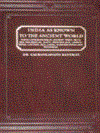

|
|
|
|
|
| Publication |
New Delhi, Asian Educational Service, 2006.
|
| Description |
73p.Hbk
|
| Contents |
Old Publication
|
| Standard Number |
8120605616
|
|
|
|
|
|
|
|
|
|
|
|
Copies: C:1/I:0,R:0,Q:0
Circulation
| Accession# | Call# | Current Location | Status | Policy | Location |
| 057974 | 934/BAN 057974 | Main | On Shelf | General | |
|
|
|
|
| 9 |
ID:
124975
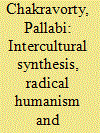

|
|
|
|
|
| Publication |
2013.
|
| Summary/Abstract |
Rabindranath Tagore imbued Indian dance and music with a new modern sensibility. He created novel and eclectic dance-and-music genres, Rabindranritya and Rabindrasangeet, when the national trend was toward classical revivalism. He inspired Indian women to dance on the national stage at a time when dance was associated with immorality and cultural degeneration. This article explores Tagore's song and dance creations, connecting them to his radical political and philosophical thought on universal humanism. Focusing on his views on creativity and freedom, nationalism and cosmopolitanism, and women and essentialism, it is argued that this eclectic intercultural synthesis of ideas served to promote individual consciousness, empowerment and cosmopolitanism without rejecting their Indic cultural roots.
|
|
|
|
|
|
|
|
|
|
|
|
|
|
|
|
| 10 |
ID:
114683
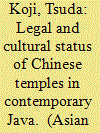

|
|
|
|
|
| Publication |
2012.
|
| Summary/Abstract |
Since the collapse of Soeharto's New Order in 1998, Indonesia has been experiencing broad political and social changes. While the Soeharto regime was generally cautionary and oppressive toward anything related to China or the ethnic Chinese, the subsequent administrations faced the pressure to make sweeping changes to existing discriminatory policies and laws, and have put these changes into action, though gradually. With this major change in the social environment, an atmosphere is being engendered across the nation, producing a feeling that anyone is free to enjoy 'Chinese culture' which for a long time was banned from being expressed in public. This spirit is palpable for example during Chinese New Year, when red lanterns and other ornate decorations, and characters such as Gong Xi Fa Cai () are seen dancing about everywhere. Along with upscale malls and hotels, it is Chinese temples (klenteng) that have become the centers of these festivities. Having been the anchorage of traditional worship for the ethnic Chinese, during the Soeharto era these facilities were the target of unfavorable treatment. In the last few years, their activities have gradually been revitalized. This article scrutinizes the changed legal and cultural status of the Chinese temples engendering changes within the Chinese community at large, by focusing on developments in post-'New Order' Java.
|
|
|
|
|
|
|
|
|
|
|
|
|
|
|
|
| 11 |
ID:
084040
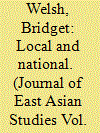

|
|
|
|
|
| Publication |
2008.
|
| Summary/Abstract |
From horrific accounts of men decapitated to "ordinary" accounts of stolen motorcycles, the routine beating and killing of alleged criminals by mobs (massa) has become common in Indonesia. This article examines the patterns of keroyokan-mobbing-from 1995 through 2004 in four provinces and highlights the temporal, spatial, and substantive variations of this phenomenon. Drawing from a database of provincial and local news clippings in Bali, Bengkulu, West Java, and South Kalimantan and in-depth case studies and interviews, this article shows that mobbing varies considerably. Its causes are national and local. The temporal data show that nationally the most important factor to influence levels of mobbing was the introduction of decentralization. The power vacuum that resulted from the policy decision to transfer authority from the center to localities increased local violence. Yet this macrolevel explanation is inadequate to show the spatial variation and different forms of mobbing violence. To understand the causes of these dimensions of variation, one has to move away from macronational approaches measuring violence and include a more microethnographic local approach. A richer understanding of mobbing must be locally rooted. This article uses three case studies to illustrate the centrality of local factors affecting this form of violence. The case studies suggest that mobbing is shaped by the acquiescence of actors in local communities and local learning. The article draws attention to the need to incorporate local data and methods into an analysis of violence in Indonesia and to appreciate varied daily rituals of violence as reservoirs of conflict.
|
|
|
|
|
|
|
|
|
|
|
|
|
|
|
|
| 12 |
ID:
186733
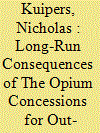

|
|
|
|
|
| Summary/Abstract |
This article examines the consequences of the opium concession system in the Dutch East Indies—a nineteenth-century institution through which the Dutch would auction the monopolistic right to sell opium in a given locality. The winners of these auctions were invariably ethnic Chinese. The poverty of Java's indigenous population combined with opium's addictive properties meant that many individuals fell into destitution. The author argues that this institution put in motion a self-reinforcing arrangement that enriched one group and embittered the other with consequences that persist to the present day. Consistent with this theory, the author finds that individuals living today in villages where the opium concession system once operated report higher levels of out-group intolerance compared to individuals in nearby unexposed counterfactual villages. These findings improve the understanding of the historical conditions that structure antagonisms between competing groups.
|
|
|
|
|
|
|
|
|
|
|
|
|
|
|
|
| 13 |
ID:
103148
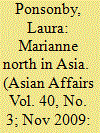

|
|
|
|
|
| Publication |
2009.
|
| Summary/Abstract |
Marianne North, a well-to-do and well-connected Victorian lady painter, made a number of expeditions to all parts of the world to paint plants and flowers in their native habitat. Over 800 of her paintings are displayed in a special gallery which she donated to Kew Gardens. The article concentrates on her travels in various parts of Asia, especially Japan, Sarawak, Java, Ceylon and India.
|
|
|
|
|
|
|
|
|
|
|
|
|
|
|
|
| 14 |
ID:
160634
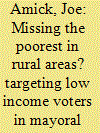

|
|
|
|
|
| Summary/Abstract |
This article utilizes an original household survey of two regency-level elections in Indonesia to explore campaign targeting. It uses a list experiment to show that direct survey questions about accepting transfers from campaigns elicit honest responses from respondents in Indonesia. Although the relationship between income and whether a respondent accepted transfers from political campaigns decreases over the entire distribution of income, it increases initially, producing a curvilinear relationship between income and accepting transfers from campaigns. This article argues that the poorest voters face barriers to being targeted by campaigns. However, these barriers recede as they become relatively richer, at which point a negative relationship is found due to diminishing marginal utility of accepting these transfers. Finally, in-kind transfers, as opposed to cash transfers, target low-income voters more effectively.
|
|
|
|
|
|
|
|
|
|
|
|
|
|
|
|
| 15 |
ID:
188732
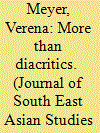

|
|
|
|
|
| Summary/Abstract |
The world, Fox shows in More than words, tends to be a lot more open-ended than we imagine, with more things in heaven and earth than are dreamt of, not just in our philosophy but also our philology. As a student of Javanese literature, I had encountered glimpses of this open-endedness on the pages of manuscripts where we sometimes find little dots on top of Javanese letters. These dots often appear in the literature of Islamic Java written in the carakan alphabet. Known to us as diacritics, they are used for originally Arabic words to produce sounds for which there is no letter in Javanese. Not all originally Arabic words get dots in Javanese texts: while a significant percentage of the Javanese vocabulary is adopted from Arabic, many words have become naturalised to the extent that their origin has become invisible. Sometimes, however, one does find dotted letters, marking words as somehow different from the other Javanese words around them. With Fox's analysis in More than words, I want to ask: how do we understand these dots? And what should we do with them?
|
|
|
|
|
|
|
|
|
|
|
|
|
|
|
|
| 16 |
ID:
099451
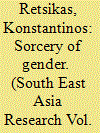

|
|
|
|
|
| Publication |
2010.
|
| Summary/Abstract |
Drawing on ethnographic material from East Java, Indonesia, this article examines the intersections of sorcery and gender and suggests that sorcery is a form of exchange, which, as well as inducing misfortune, pain and death, evinces gender. Key here are the invocation and inversion of marriage transactions and wedding rituals, and an underlying conception of the person as inherently androgynous. The article also calls for sorcery and other manifestations of violence to be moved away from the margins and towards the centre of anthropological descriptions of Javanese sociality.
|
|
|
|
|
|
|
|
|
|
|
|
|
|
|
|
| 17 |
ID:
151655
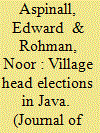

|
|
|
|
|
| Summary/Abstract |
To explore how democratisation is transforming Indonesia's rural elite, we examine two village head elections in Central Java. Despite the competitiveness of these elections, the campaigning modes employed by candidates, especially vote buying, points to elite continuity, because only wealthy villagers can compete for office. Moreover, links with higher state officials remain important for village elites, allowing them to win political support by obtaining projects from local government. However, rather than being incorporated as subordinates in a bureaucratic hierarchy as during authoritarian rule, village elites are now true rural brokers, exercising considerable leverage in their relations with the state.
|
|
|
|
|
|
|
|
|
|
|
|
|
|
|
|
| 18 |
ID:
099066
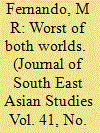

|
|
|
|
|
| Publication |
2010.
|
| Summary/Abstract |
This paper deals with the consequences of the increasing commercialisation of the rice industry in west Indramayu from the mid-1880s to the late 1930s. Instead of prosperity as a result of growing rice for sale in a free market, local peasants found their survival being threatened by traders who had them bound to a vicious cycle of debts and who acquired much of the rice they produced. The rice growers in west Indramayu were impoverished far more than the peasants growing cash crops such as sugar elsewhere in Java.
|
|
|
|
|
|
|
|
|
|
|
|
|
|
|
|
|
|
|
|
|